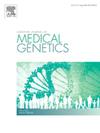ARID1A基因变异与胎儿脑积水:mRNA衰变逃逸的第一个证据。
IF 1.7
4区 医学
Q3 GENETICS & HEREDITY
引用次数: 0
摘要
ARID1A的种系变异与所谓的BAFopathies有关,包括Coffin-Siris综合征,其特征是多毛,短的无名指,薄的上唇和厚的下唇,与独特的表观特征有关。直到最近,当ARID1A变异与产前发作的脑积水有关时,脑积水才被认为是BAFopathy的一部分。目前尚不清楚arid1a相关的脑积水是否与特定类型的变异有关,以及它是否表现出与BAFopathies相当的特征。我们对一名19周时经产前超声诊断为严重脑积水的胎儿进行了基因组和表观基因组分析。经过详细的遗传咨询,在怀孕21周时终止了妊娠。出生的胎儿表现为五指短,上唇薄,下唇厚。使用脐带血进行死后外显子组测序,在ARID1A (NM_006015.6:c)的最后一个外显子中发现了一个新的杂合移码变异。5259 _5262dupgtct, p。(Ser1755Valfs * 2))。最后一个外显子的移码变体有望逃脱无义介导的mRNA衰变(NMD),我们确实通过RNA-seq证实了这一点。通过纳米孔测序和基于支持向量机的分类器同时进行的表观特征分析显示,胎儿映射到BAFopathy组,而不是在UMAP上的单独位置。对先前关于脑积水和潜在的NMD逃逸的报告中未发表的数据进行基因型-表型相关分析,并结合原作者的输入,表明这种关联仍然不明确。因此,arid1a相关的脑积水发生在更广泛的BAFopathies的临床和表观基因组谱中,但NMD逃逸引起的独特遗传机制不太可能发挥作用。本文章由计算机程序翻译,如有差异,请以英文原文为准。
ARID1A gene variants and fetal hydrocephalus: First evidence of mRNA decay escape
Germline variants in ARID1A have been associated with the so-called BAFopathies, including Coffin-Siris syndrome, which is characterized by hypertrichosis, short fifth finger, thin upper lip, and thick lower lip, is associated with a unique episignature. Hydrocephalus has not been considered part of BAFopathy until recently, when ARID1A variants were implicated in prenatal-onset hydrocephalus. It remains unknown whether ARID1A-associated hydrocephalus is linked to a specific class of variants and whether it exhibits an episignature comparable to that of BAFopathies. We conducted genomic and epigenomic analyses on a fetus diagnosed with severe hydrocephalus on prenatal ultrasound at 19 weeks. After detailed genetic counseling, the pregnancy was terminated at 21 weeks. The delivered fetus exhibited short fifth fingers, thin upper lip, and thick lower lip. Postmortem exome sequencing using umbilical cord blood identified a de novo heterozygous frameshift variant in the last exon of ARID1A (NM_006015.6:c.5259_5262dupGTCT, p.(Ser1755Valfs∗2)). The frameshift variant in the last exon was expected to escape nonsense-mediated mRNA decay (NMD), and we did confirm this through RNA-seq. Concurrent episignature analysis by nanopore sequencing and a support vector machine-based classifier showed that the fetus maps to the BAFopathy group rather than a separate position on the UMAP. Genotype-phenotype correlation analysis of unpublished data from previous reports regarding hydrocephalus and potential NMD escape, with input from the original authors, indicated that the association remains ambiguous. Hence, ARID1A-associated hydrocephalus occurs within the broader clinical and epigenomic spectrum of BAFopathies, but a distinct genetic mechanism caused by NMD escape is unlikely to play a role.
求助全文
通过发布文献求助,成功后即可免费获取论文全文。
去求助
来源期刊
CiteScore
4.10
自引率
0.00%
发文量
193
审稿时长
66 days
期刊介绍:
The European Journal of Medical Genetics (EJMG) is a peer-reviewed journal that publishes articles in English on various aspects of human and medical genetics and of the genetics of experimental models.
Original clinical and experimental research articles, short clinical reports, review articles and letters to the editor are welcome on topics such as :
• Dysmorphology and syndrome delineation
• Molecular genetics and molecular cytogenetics of inherited disorders
• Clinical applications of genomics and nextgen sequencing technologies
• Syndromal cancer genetics
• Behavioral genetics
• Community genetics
• Fetal pathology and prenatal diagnosis
• Genetic counseling.

 求助内容:
求助内容: 应助结果提醒方式:
应助结果提醒方式:


